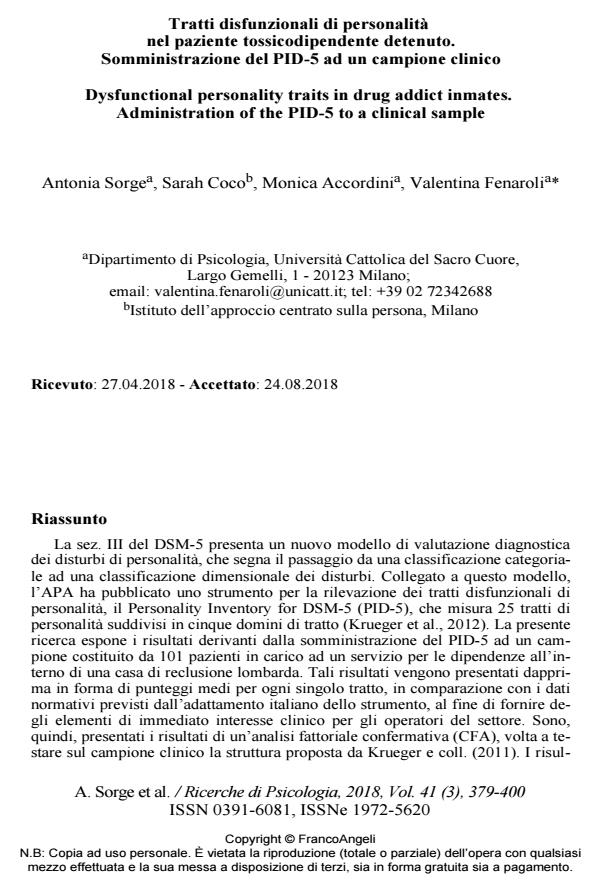Tratti disfunzionali di personalità nel paziente tossicodipendente detenuto. Somministrazione del PID-5 ad un campione clinico
Titolo Rivista RICERCHE DI PSICOLOGIA
Autori/Curatori Antonia Sorge, Sarah Coco, Monica Accordini, Valentina Fenaroli
Anno di pubblicazione 2018 Fascicolo 2018/3
Lingua Italiano Numero pagine 22 P. 379-400 Dimensione file 106 KB
DOI 10.3280/RIP2018-003005
Il DOI è il codice a barre della proprietà intellettuale: per saperne di più
clicca qui
Qui sotto puoi vedere in anteprima la prima pagina di questo articolo.
Se questo articolo ti interessa, lo puoi acquistare (e scaricare in formato pdf) seguendo le facili indicazioni per acquistare il download credit. Acquista Download Credits per scaricare questo Articolo in formato PDF

FrancoAngeli è membro della Publishers International Linking Association, Inc (PILA)associazione indipendente e non profit per facilitare (attraverso i servizi tecnologici implementati da CrossRef.org) l’accesso degli studiosi ai contenuti digitali nelle pubblicazioni professionali e scientifiche
La sez. III del DSM-5 presenta un nuovo modello di valutazione diagnostica dei disturbi di personalità, che segna il passaggio da una classificazione categoriale ad una classificazione dimensionale dei disturbi. Collegato a questo modello, l’APA ha pubblicato uno strumento per la rilevazione dei tratti disfunzionali di personalità, il Personality Inventory for DSM-5 (PID-5), che misura 25 tratti di personalità suddivisi in cinque domini di tratto (Krueger et al., 2012). La presente ricerca espone i risultati derivanti dalla somministrazione del PID-5 ad un campione costituito da 101 pazienti in carico ad un servizio per le dipendenze all’interno di una casa di reclusione lombarda. Tali risultati vengono presentati dapprima in forma di punteggi medi per ogni singolo tratto, in comparazione con i dati normativi previsti dall’adattamento italiano dello strumento, al fine di fornire degli elementi di immediato interesse clinico per gli operatori del settore. Sono, quindi, presentati i risultati di un’analisi fattoriale confermativa (CFA), volta a testare sul campione clinico la struttura proposta da Krueger e coll. (2011). I risul tati confermano la tenuta dei 5 domini di tratto sul campione clinico in oggetto, seppur con alcune differenze rispetto al numero complessivo di tratti (15 anziché 25) che compongono ciascun dominio. Nello specifico, alcune sotto-dimensioni maladattive (ad es. manipolatorietà, angoscia di separazione, ostilità, sospettosità, insensibilità, ecc.) non convergono in modo univoco su un dominio di tratto e sono state per questo eliminate dal modello. Lo studio, per quanto preliminare, offre alcuni primi spunti di riflessione sul legame tra disturbi di personalità, utilizzo di sostanze stupefacenti e condotte devianti, mostrando come l’adozione di una prospettiva complessa possa contribuire a mettere a fuoco interventi più mirati, quindi più efficaci, nei contesti clinici.
Parole chiave:DSM-5, PID-5, tratti disfunzionali di personalità, disturbi di personalità, sostanze stupefacenti.
Antonia Sorge, Sarah Coco, Monica Accordini, Valentina Fenaroli, Tratti disfunzionali di personalità nel paziente tossicodipendente detenuto. Somministrazione del PID-5 ad un campione clinico in "RICERCHE DI PSICOLOGIA " 3/2018, pp 379-400, DOI: 10.3280/RIP2018-003005